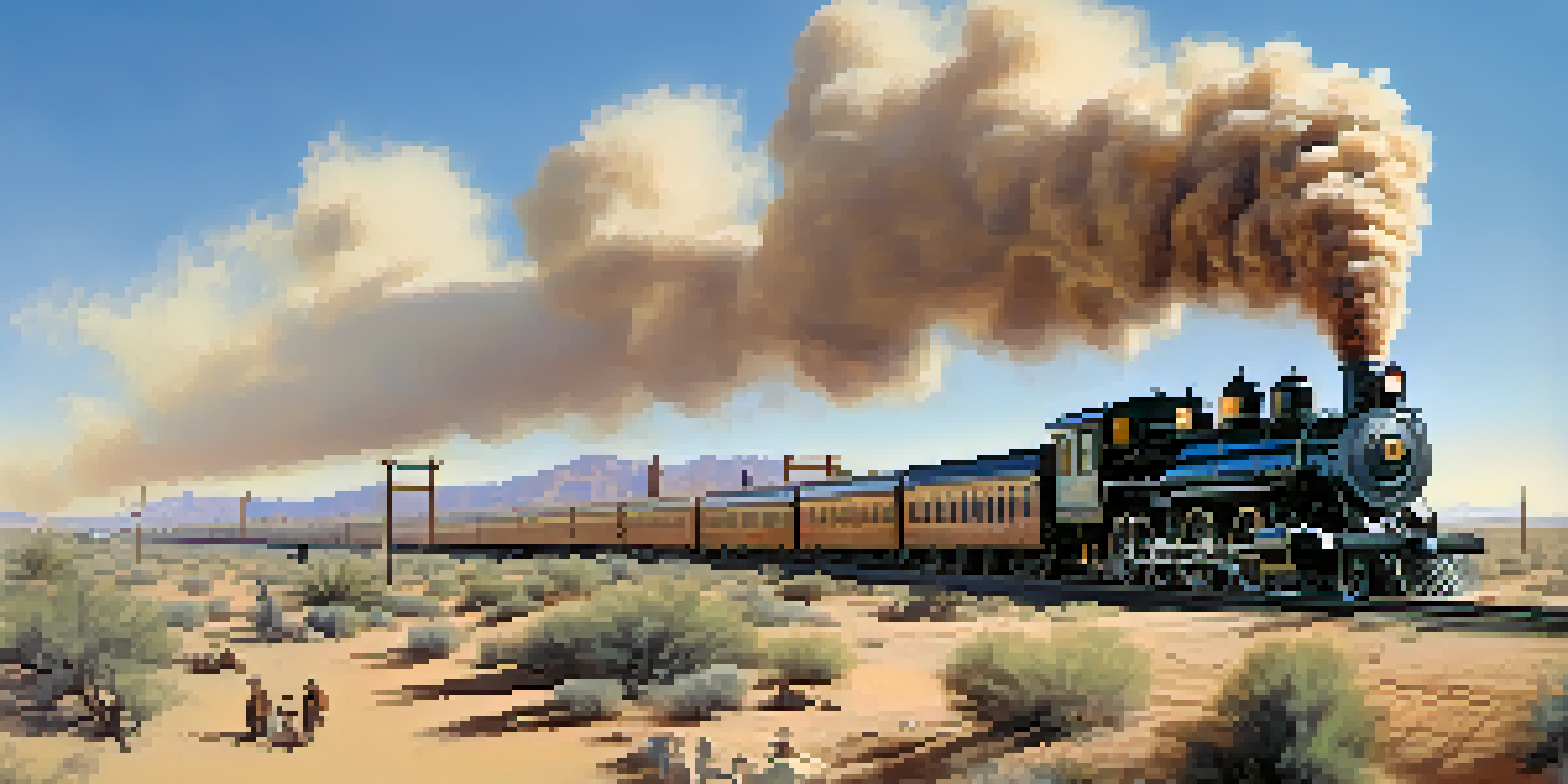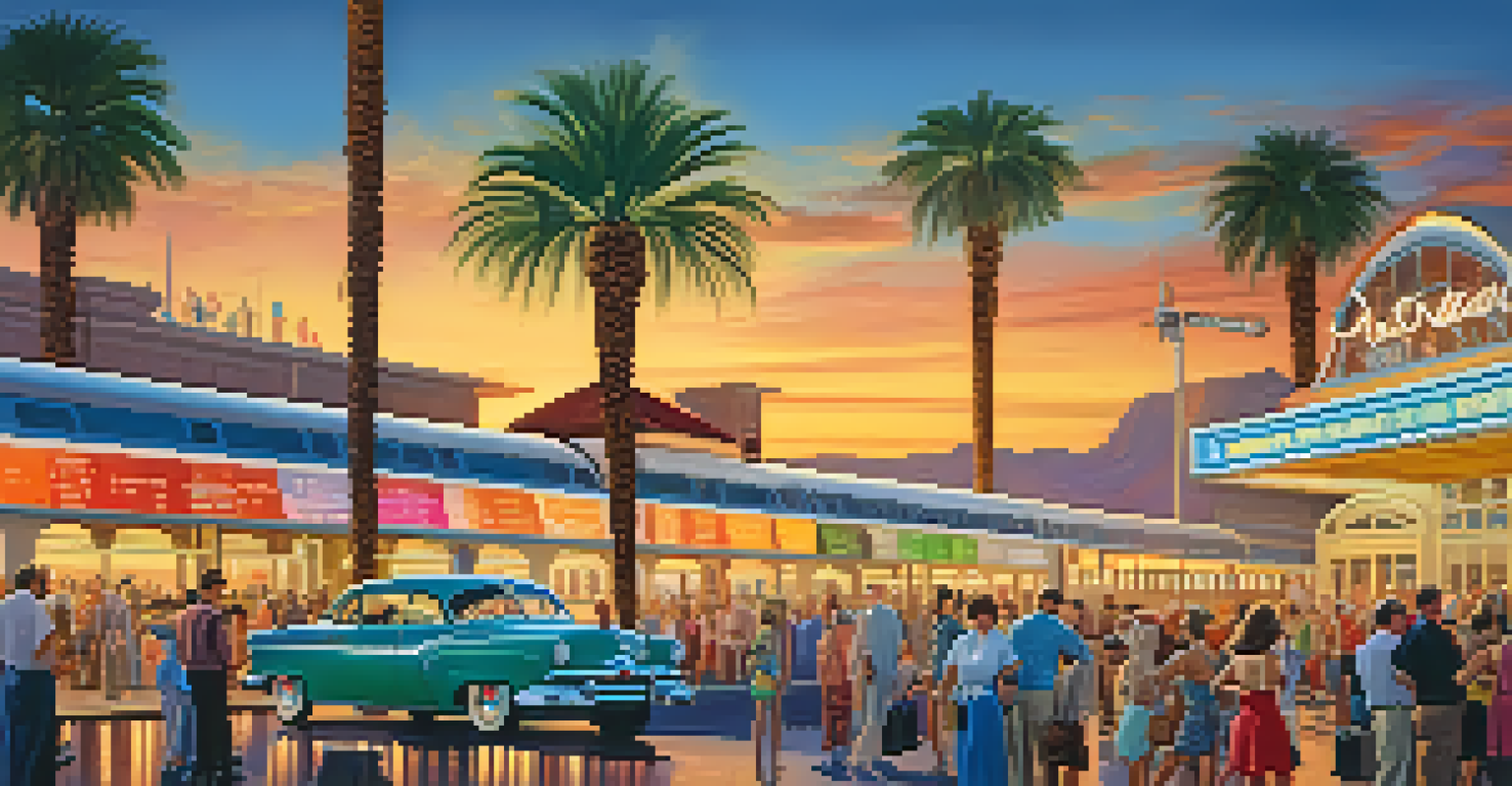The Role of the Railroad in Las Vegas' Early Growth

The Formation of Las Vegas: A Railroad Crossroads
Las Vegas began as a humble watering hole for travelers crossing the Mojave Desert. Its strategic location made it an ideal stop for those journeying to California. In the late 19th century, the arrival of the railroad transformed this small settlement into a bustling hub.
The railroad is a remarkable institution, for it has transformed the way we connect and experience our world.
The Southern Pacific Railroad played a pivotal role by connecting Las Vegas to major cities. This link not only brought in goods and services but also attracted settlers and businesses seeking opportunities. The sound of the train whistle began to symbolize hope and progress.
As more rail lines were established, the population grew, and so did the economy. Las Vegas started to evolve from a mere waypoint into a thriving community, setting the stage for its future as a vibrant city.
Economic Boom: The Railroad and Local Industry
With the railroad in place, Las Vegas experienced an economic surge that was hard to ignore. Local industries such as agriculture flourished as farmers could easily transport their goods to larger markets. The connection to the railroads allowed for fresh produce and livestock to reach consumers quickly.

Additionally, the mining industry benefited greatly from the railroads. Valuable minerals could be shipped efficiently to processing centers, leading to a boom in mining activity in the surrounding areas. This not only provided jobs but also attracted a workforce eager to find their fortune.
Railroads Fueled Las Vegas' Growth
The arrival of the railroad transformed Las Vegas from a simple watering hole into a thriving community and economic hub.
As businesses thrived, so did the local economy, creating a ripple effect that encouraged further growth. The railroad was not just a means of transport; it was the backbone of Las Vegas' early industry, laying the groundwork for future prosperity.
Connecting Communities: The Social Impact of Railroads
The arrival of the railroad in Las Vegas wasn't just an economic game-changer; it also had profound social implications. It connected families and friends who were previously separated by vast distances. Suddenly, travel became more accessible, fostering a sense of community among those who called Las Vegas home.
A community is built on connections; railroads have always been the veins that carry the lifeblood of opportunity.
As people flocked to the area, cultural diversity began to flourish. Different communities brought their traditions, food, and customs, enriching the social fabric of the city. This melting pot of cultures helped shape a unique identity for Las Vegas.
Events and gatherings became more frequent, allowing residents to bond over shared experiences. The railroads played a crucial role in bringing people together, turning Las Vegas into not just a stopover but a place where relationships could flourish.
The Role of Railroads in Shaping Infrastructure
With the influx of residents and businesses, the need for infrastructure grew exponentially. The railroad's presence prompted the development of roads, bridges, and public buildings. This infrastructure was vital for supporting a growing population and economy.
Investment in public services such as schools, hospitals, and parks followed closely behind. The community began to establish itself with the amenities necessary for a thriving city. The railroad not only brought people but also the resources required to build a sustainable environment.
Tourism Thrived with Train Access
The railroad facilitated easy access for tourists, paving the way for Las Vegas to evolve into a major entertainment destination.
As Las Vegas expanded, the importance of reliable infrastructure became clear. The railroad had catalyzed a transformation, helping the city evolve from a desolate outpost into a well-organized urban center.
Tourism and the Railroad: A New Era Begins
As Las Vegas began to establish itself, the railroad opened the door to tourism. Visitors could now easily travel to the city, drawn by its desert charm and burgeoning attractions. The local economy soon began to thrive on this new influx of tourists.
Hotels, casinos, and entertainment venues started popping up along the main rail lines. The railroad not only facilitated travel but also allowed businesses to cater to the leisure needs of visitors. This marked the beginning of Las Vegas' transformation into the entertainment capital we know today.
The railroad's role in boosting tourism cannot be overstated, as it laid the groundwork for a thriving hospitality industry. This new economic focus would shape the future of Las Vegas, turning it into a world-renowned destination.
Challenges Faced by the Railroad in Early Las Vegas
Despite the positive impact of the railroad, challenges were undeniably present. The harsh desert environment posed significant obstacles in maintaining rail lines and ensuring safe travel. Extreme weather conditions and shifting sands often disrupted service.
Additionally, competition from other transportation methods, such as automobiles, began to emerge. As roads improved and personal vehicles became more common, the reliance on rail transport started to wane. This shift created uncertainty for the railroad's future in Las Vegas.
Railroads Shaped Community Connections
Beyond economics, railroads fostered social connections, enriching the city's cultural diversity and sense of community.
Despite these challenges, the railroad remained a critical component of Las Vegas' early development. Its ability to adapt and evolve in response to changing circumstances highlighted its importance in the city's history.
The Lasting Legacy of Railroads in Las Vegas
Today, the influence of railroads on Las Vegas is still evident in many ways. The city has grown into a major metropolitan area, yet the foundational role of the railroad cannot be overlooked. It set the stage for the vibrant community that exists today.
The legacy of the railroad continues to shape the city's identity, reminding residents and visitors alike of its humble beginnings. Las Vegas' growth story is one of innovation, resilience, and community, driven largely by the introduction of rail transport.

As we look back, we see how the railroad was more than just a means of travel; it was a catalyst for transformation. The early days of Las Vegas serve as a powerful reminder that even the most unlikely of places can flourish with the right connections.